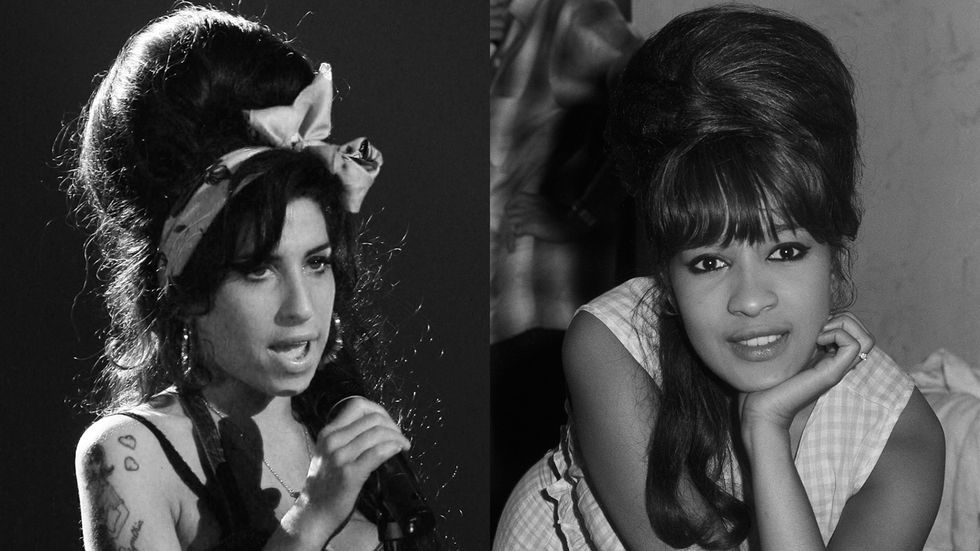When Amy Winehouse made a huge splash onto the music scene with Back to Black in 2006, her skintight dresses, bouffant hair and heavily lined eyes all heralded back to one person: Ronnie Spector, lead singer for 1960s girl group the Ronettes. Winehouse was like an updated version of Ronette-era Spector, albeit with a darker funhouse mirror twist. But there’s more linking Winehouse and Spector than their style choices: Spector’s music influenced Winehouse’s own, and both experienced personal turmoil. Spector was aware of the parallels between the two and was grateful for the connection they shared. “Amy Winehouse was so great for me because she made me feel like what I did mattered,” Spector said in a 2015 interview.
They discovered their musical talent at a young age
Winehouse and Spector were both young performers. Spector’s singing delighted her family and irritated teachers at school. Winehouse sang her way into art school. They each embraced their gifts: Spector stepped onstage at Harlem’s Apollo Theater when she was 11; Winehouse was writing her own music by the time she was 14. And both were pros in their teens. Spector as lead singer for the Ronettes; Winehouse in making her first album, Frank.
Spector and Winehouse were each swept up in the kind of success that upends lives. As “Be My Baby” climbed the charts in 1963, the Ronettes became huge stars — the Rolling Stones were an opening act when the girl group toured the United Kingdom. And Winehouse’s Back to Black, with singles like “Rehab,” transformed her into a superstar — but it also led to her having to live in the spotlight.

Photos: Rob Verhorst/Redferns; Gilles Petard/Redferns
Amy Winehouse and Ronnie Spector
The singers had a similar style
As her career took off in the 1960s, Spector became known as “the original bad girl of rock ‘n’ roll” thanks largely to how she and the Ronettes were dressed. While other girl groups of the era wore flared, more sedate dresses, her group pushed boundaries with their short skirts, which were worn tight and with slits that left just enough room to dance. The Ronettes’ style was an inspiration to Winehouse. When her second album, Back to Black, was released, she sported multiple tattoos and tight strapless dresses, and was anything but coy and demure — she’d taken Spector’s attire and created a version of it for the 21st century.
In addition, the towering beehive hairdo associated with Winehouse was first seen on Spector. During the Ronettes’ heyday, Spector’s long hair would be teased for volume, stacked on her head, then sealed in place with plenty of Aqua Net hairspray. And decades before Winehouse was evoking Cleopatra by lining her eyes with dark, thick swoops, Spector and her bandmates had piled on the mascara and eyeliner. “Every time I looked at her, it was like I was looking at myself. She had my beehive, my eyeliner, my attitude,” Spector said in Rolling Stone shortly after Winehouse’s death in 2011.
Spector and Winehouse inspired each other’s music
Winehouse wasn’t just won over by how the Ronettes looked — she also loved their music. During a roller-coaster romantic relationship and subsequent devastating break-up with Blake Fielder-Civil, the sounds of Spector singing with the Ronettes, as well as the work of other ’60s girl groups, were a constant for Winehouse. And listening to this music helped her create the hugely successful Back to Black.
The ’60s girl groups that Winehouse admired hadn’t shied away from singing about the obsession and excess that love, requited or not, can lead to. Spector demonstrated this with her powerful vocals for songs such as “Be My Baby” and “The Best Part of Breakin’ Up.” On Back to Black, many of Winehouse’s songs, such as “Love Is a Losing Game” and the cover track, delved even further into the harsh emotional toll of relationships. Like Spector, Winehouse had a raw, distinctive voice that could leave audiences feeling as though their deepest emotions had finally been expressed.
The Ronettes had lit a fire in Winehouse, and in a turnaround, the younger star’s singing became an inspiration to Spector. She loved Winehouse’s voice and began to sing “Back to Black” at her shows. Spector has said Winehouse once got to hear her performing this song in London, which brought both of them to tears. After Winehouse’s death, Spector released a charity single of the song and the proceeds went to a substance abuse center.
Spector and Winehouse had turbulent personal lives
Neither Spector nor Winehouse was a stranger to troubled relationships. Spector wed producer Phil Spector in 1968 and ended up a near-prisoner in their luxurious Los Angeles home. She eventually revealed that her husband exercised such control over their life together that he adopted two children without telling her. As for Winehouse, her break-up with Fielder-Civil didn’t last. The two had a spur-of-the-moment wedding in 2007, but the marriage devolved into a tabloid spectacle, featuring fights, drug use, and arrests.
Being trapped in a nightmare of a marriage led to Spector’s drinking getting out of control (she noted in her memoir, Be My Baby: How I Survived Mascara, Miniskirts and Madness, it was also a way to get out of the house). But she was able to quit drinking after she left Phil in 1972 (they divorced two years later). Unfortunately, Winehouse’s dependence on alcohol seemed to grow, even after she and Fielder-Civil divorced in 2009. She died on July 23, 2011, due to accidental alcohol poisoning.
Spector was among the many devastated by Winehouse’s death. “She loved the girl groups. I was in shock to see her go,” she said in 2012.

